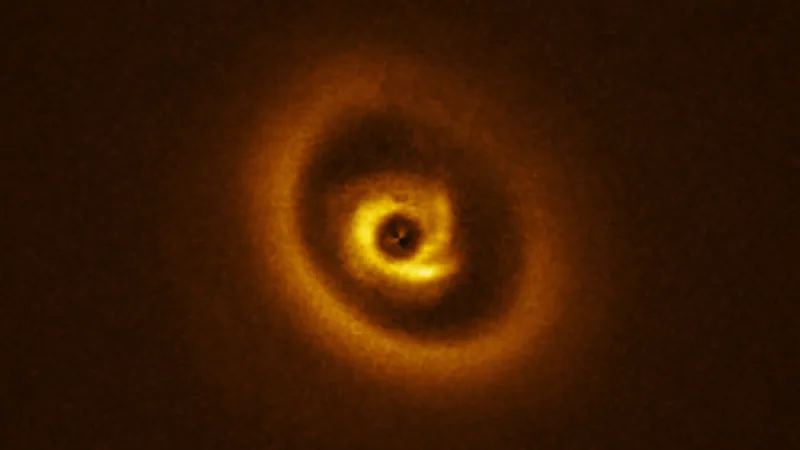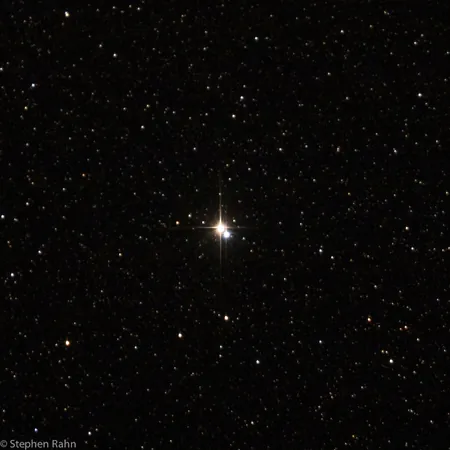
Astronomers Capture Stunning Image of a Young Star Creating a Giant Planet!
2025-06-09
Author: Jacob
Researchers have unveiled a breathtaking image that hints at the birth of a colossal planet orbiting a distant young star, shedding new light on the mysteries of planet formation.
Captured by the European Southern Observatory's Very Large Telescope in Chile, this captivating image showcases the star surrounded by a vivid, eye-shaped disk of swirling gas and dust. A dark ring within this disk suggests the gravitational pull of a nascent planet—likely a massive gas giant—sucking in surrounding material as it orbits its star.
Lead author Christian Ginski, a lecturer at the University of Galway in Ireland, shared his insights, stating, "We are talking about a fairly massive planet here, several times the mass of Jupiter. It clears a path as it circles the star, almost like a vacuum cleaner, drawing in dust and debris."
This discovery could be one of the rare instances where a planet is detected while still in its formative stages. Ginski and his team have even created a simulation of the potential exoplanet within the disk and aim to confirm its existence using the James Webb Space Telescope in the near future.
Their findings, released on June 9 to the preprint database arXiv, are slated for publication in the journal Astronomy & Astrophysics.
Ginski and his colleagues are on a quest to deepen our understanding of planetary systems and the physical forces necessary to forge solar systems akin to our own. While thousands of exoplanets have been identified around other stars, most are significantly older.
"We’re essentially investigating the aftermath of a meal that's already been cooked," Ginski noted. "Identifying young planets within their formation disks provides insights into all the essential ingredients and their interactions. To date, we’ve confirmed just one planet in its early stages, with a few more candidates that are yet to be fully validated."
The young star at the center of this groundbreaking image is designated 2MASSJ16120668-3010270, or 2MASSJ1612 for brevity, located an astounding 430 light-years away from our solar system. A previous study in 2024 had already highlighted a gap in the star's disk, raising suspicions about ongoing planet formation.
For the first time, 2MASSJ1612 was observed in scattered near-infrared light, revealing intricate details, including two spiral arms spiraling from the center of its disk. Ginski explained that these arms are formed by the gravitational influence of the planet, which disturbs the disk and creates density waves—much like ripples originating from a stone tossed into water.
"Imagine the stone perturbing the water, sending out waves, just like the planet in its disk," Ginski illustrated. "Now think of the stone skipping across the surface instead of sinking straight in—this creates even more complex wave patterns leading to the formation of those stunning spiral structures around the star."
Having observed around 100 young star systems, Ginski expressed his excitement over this discovery, noting that researchers typically encounter either the carved-out rings or spiral formations. In this case, both features were visually confirmed, aligning with theoretical models of planet formation. Ginski felt as if he were "a kid on Christmas morning" upon first seeing these extraordinary images.









 Brasil (PT)
Brasil (PT)
 Canada (EN)
Canada (EN)
 Chile (ES)
Chile (ES)
 Česko (CS)
Česko (CS)
 대한민국 (KO)
대한민국 (KO)
 España (ES)
España (ES)
 France (FR)
France (FR)
 Hong Kong (EN)
Hong Kong (EN)
 Italia (IT)
Italia (IT)
 日本 (JA)
日本 (JA)
 Magyarország (HU)
Magyarország (HU)
 Norge (NO)
Norge (NO)
 Polska (PL)
Polska (PL)
 Schweiz (DE)
Schweiz (DE)
 Singapore (EN)
Singapore (EN)
 Sverige (SV)
Sverige (SV)
 Suomi (FI)
Suomi (FI)
 Türkiye (TR)
Türkiye (TR)
 الإمارات العربية المتحدة (AR)
الإمارات العربية المتحدة (AR)